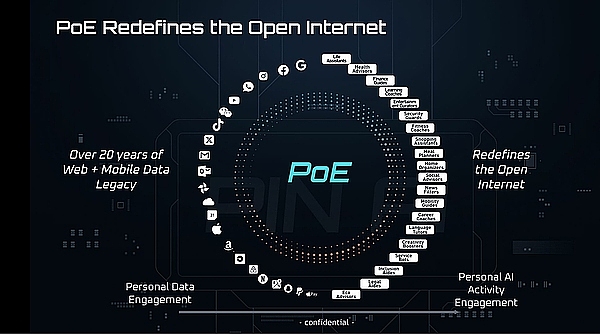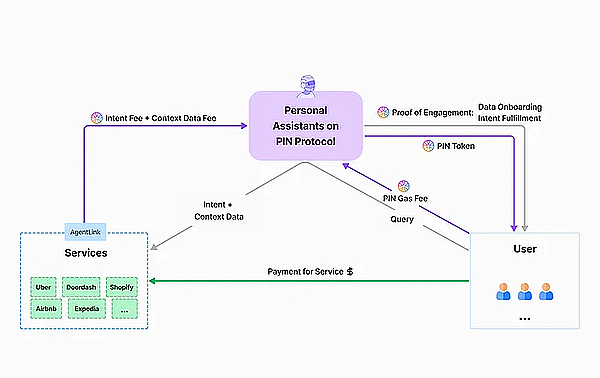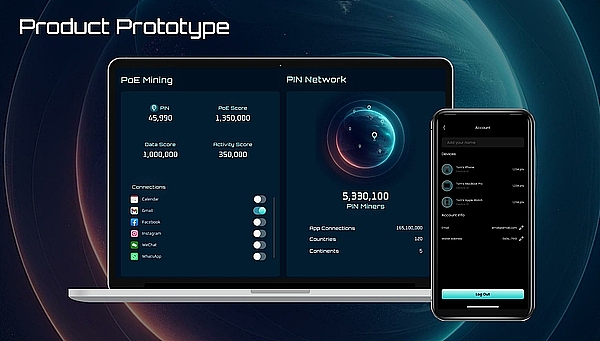It is an honor to complete this research under the guidance of Meteorite Labs, based on the experience exchange of hundreds of Web2 AI applications.
PIN AI is a selected project of the a16z Crypto Startup Accelerator Fall Program, with a seed round of financing of US$10 million. In addition to a16z Crypto, well-known VCs include Stanford Blockchain Accelerator, Hack VC, and Foresight Ventures. Angel investors include Illia Polosukhin, founder of NEAR Protocol, Scott Moore, co-founder of Gitcoin, Lily Liu, chairman of Solana Foundation, Evan Cheng, CEO of SUI/Mysten Labs, and DCBuilder, research engineer of Worldcoin.
I just finished reading the article co-written by the three co-founders of PIN AI, and found that it is the most attractive Web3 AI project to me recently besides Sahara, and the application scenario is very interesting. (Article link: https://www.pinai.io/post/pin-ai-the-open-platform-for-personal-ai)
PIN AI is an open AI network where developers can build useful AI applications. "Useful AI Applications", <useful> is the focus of its products. It is a bit like AI Agents such as MultiOn and Jace.ai of Web2, and is committed to providing users with applications that are useful for daily life and realizing the intentions proposed by users, such as online purchases, travel planning, and investment planning.

Brief introduction to Jace.ai, an AI agent that can complete browser tasks autonomously, based on LLM and its proprietary model AWA-1 (Autonomous Web Agent-1), which supports AI to perform operations on web pages.
Jace's greatest ability is to plan tasks autonomously and perform operations in the browser on behalf of users.
Let's take an example to understand the application scenario. Tell Jace, "I plan to travel to Beijing for a week on September 20th, with a budget of 5,000 yuan. Help me plan it." Jace will automatically plan a travel plan, including attractions to visit, hotels to stay in, and food to eat. If I agree to this travel plan, it will help me book all the scenic spots, find the most cost-effective hotel on Meituan and place an order. I only need to enter my personal information and pay with one click.
In fact, what PIN AI does is very similar. The biggest difference from generative AI is that this type of AI project focuses on the user's daily life rather than work.
1. Deconstructing PIN AI design ideas
In simple terms, PIN AI = AI + DePIN
PIN AI network consists of two types of AI:
Personal AI: Personalized AI Agent that can adapt to user preferences in real time. It is the connection point between users and agent services, a bit like a coordinator. Users can download it to their mobile phones or computer devices for use.
Agentic Services: AI Agents built on the chain for Web2 platforms can perform tasks on some top Web2 platforms, and the execution process and completion status are recorded on the blockchain
The official also mentioned External AI, which may support interaction with other LLM or Web2 AI Agents in the future.
PIN AI Architecture Core:
PIN Protocol, a DePIN distributed data storage network, allows anyone to connect their devices to the network and share data. It integrates a BERT-based model to anonymize data at all stages of processing user data, ensuring privacy and complying with data protection regulations.
Personal AI is built into it. On the one hand, it provides personalized data for personal AI, and on the other hand, it provides the most relevant data for agent services.
PIN Protocol is built with three components:
1. Private storage and computing layer: Distributed storage data, securely storing device data shared by users (including photos, videos, etc.), and making the most relevant data readily available for personal AI and proxy services. Users can connect their devices to the network, provide device data, and receive native tokens $PIN rewards.
2. Data connector: Use zk technology to track and verify user data connected to the network. I think it is equivalent to the node of the PIN network. The node operator needs to stake $PIN tokens for verification, and some token holders can stake tokens to the node, and both can get token staking rewards.
3. Proxy link: Aims to match personal AI with proxy services. It consists of a proxy registry and a transaction mechanism. The former is used to track performance indicators, while the latter "thinks" about how to match personal AI with proxy services (based on the cost, performance and completion quality of each proxy service)
User usage pattern/business logic:
When a user uses it, after making a specific demand, PIN AI will follow the following steps:
Step 1: Personal AI - Collect user's requirements
The user makes a demand to the personal AI, and the personal AI transfers the demand to the PIN Protocol
Step 2: PIN Protocol - Prepare for task execution
Disassemble the user's intention into specific steps, find the most suitable and cost-effective proxy service, retrieve the most relevant data, and provide it to the proxy service. (If multiple Web2 platforms are involved, the intent needs to be split to different proxy services)
Step 3: Proxy service - execute specific steps
Step 4: PIN Protocol - feedback results to users
After all, most of the time, daily life needs require money transactions. In PIN AI, the flow of funds should be:
The user pays the Gas fee to the PIN Protocol (personally guessing that it may be to activate this intent transaction). Since the PIN Protocol first disassembles the user's intent, and then indexes and sends the data most relevant to the intent to the proxy service, the proxy service will return part of the service fee as a tip to the PIN Protocol after completing the task.
Therefore, both the PIN Protocol and the proxy service can extract a share of the service fee given by the user.

For example:
Users can download personal AI to their computers or mobile phones, make demands to personal AI, such as "buy the cheapest GTX 3080 graphics card on Amazon", and pay the fees (purchase fee + service fee + PIN Protocol Gas fee).
Personal AI conveys this demand to PIN Protocol.
After understanding and disassembling the user's intention, PIN Protocol will disassemble the user's intention into specific task steps and send them to the proxy service together with the most relevant data. There may be dozens of proxy services dedicated to Amazon shopping at the same time, so PIN Protocol needs to comprehensively consider their costs, performance and past completion and select the most suitable one.
The proxy service finds the most cost-effective GTX 3080 graphics card on Amazon and places an order. After completion, the intention disassembly fee and data call fee will be paid to PIN Protocol. PIN Protocol and personal AI feedback the results to the user and send the user PIN tokens as rewards.
Network Participants
Personal AI users: Install personal AI on a computer or mobile phone, connect personal data to PIN Protocol, and get PIN token rewards.

Value transfer users: Like the above usage model, users who make valuable transactions will also receive PIN token rewards.
PIN Protocol nodes: Track and verify user data connected to the network. Operators need to pledge, and token holders can pledge tokens to nodes, and both can receive pledge rewards.
Agency services: Developers can earn service fees.
II. Core Development Team
Davide Crapis - Co-founder
Blockchain protocol design background, some AI background
Worked as a senior data scientist at Lyft, designed and implemented an incentive allocation algorithm, and issued xx dollars of growth incentives to passengers and drivers every year. After resigning, he worked as an independent researcher for a while, studying incentive schemes and token allocation. Before founding PIN AI, he worked as a research scientist in the direction of "robust incentives" at the Ethereum Foundation.
I have developed a machine learning model for "consumer sensitivity to interest rates of investment/credit products" and worked as a researcher and mentor in the field of machine learning at Columbia Business School for four years. I have joined the Web2 developer community "South Park" to explore the intersection of large language models and blockchain.
Ben Wu - Co-founder
Operational background, may provide strategic direction and AI product ideas
Graduated from MIT, Y Combinator alumnus. Before founding PIN AI, worked as the database and operations director in Yahoo's Strategic Data Solutions Division, responsible for the operation and management of large-scale data projects.
Bill Sun - Co-founder, Chief Scientist
Quantitative trading and AI background
PhD in mathematics from Stanford University, worked on AI research at Google DeepMind. Worked as an artificial intelligence/quantitative trading stock investment manager at a Wall Street asset management company. Founded AI research organization AI+Club and AI technology community AGI House. Angel investor of a16z scout fund. He is also the founder of Generative Alpha, which provides enterprise-level AI solutions.
III. Thoughts and Conclusions
In the first industrial revolution, machines freed our hands;
In the second industrial revolution, electricity broke the boundary between day and night;
In the third industrial revolution, the Internet merged the boundaries between the virtual and the real.
The emergence of AI is generally considered to be the symbol of the fourth industrial revolution, and AI Agent is the ticket for this exploration journey. Each of us can board this giant ship heading to the future of "human-computer interaction".
In the past few decades, a large number of activities and massive amounts of data have been taking place on the Internet every day, but users do not have ownership of these data.
The iPhone 16 has just been released, bringing Apple Intelligence, but PIN AI has the opportunity to build an AI Agent ecosystem that is more open than Apple Intelligence.
In this, developers can get rewards by developing innovative Web2 platform proxy services, which will give birth to AI Agents with higher and higher performance and quality, triggering a wave of innovation.
Billions of mobile phone users can not only use personalized personal AI, but also share device data to get rewards.
Users' data supports the entire PIN AI ecosystem. This is the power of users, and it is also the starting point of Web3 - decentralization and ownership.
I hope to see the landing of the PIN AI network as soon as possible and whether the incentive mechanism it brings can play an effective role, so that a large number of open source contributors can flock to it, and then create a larger wave of innovation. The test network may be launched in October, and the main network and TGE will be launched in January next year. It is worth looking forward to.
 Dante
Dante
 Dante
Dante JinseFinance
JinseFinance JinseFinance
JinseFinance JinseFinance
JinseFinance JinseFinance
JinseFinance JinseFinance
JinseFinance JinseFinance
JinseFinance JinseFinance
JinseFinance JinseFinance
JinseFinance Cointelegraph
Cointelegraph